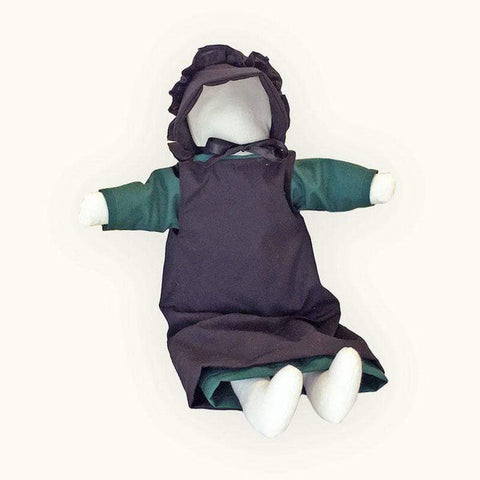The Amish are known for leading a very simple lifestyle, free from most of the trappings of modern society. As a deeply devout Christian denomination, many Amish traditions can be traced to their strong religious beliefs. But that is not the whole story.
They have fascinating norms, traditions, and customs that have been handed down from one generation to the next. Just like any other cultural group, some of their traditions have been shaped by external influences.
To better understand any culture, it’s wise to look at the history of its traditions. So, join us as we examine the genesis and development of Amish traditions, and the role that they play in Amish communities today.
What this article covers:
- Amish Norms
- Amish Traditions and Customs
- Unusual Amish Traditions That Are More Faith and Values-Based
- Amish Family Traditions
Amish Norms
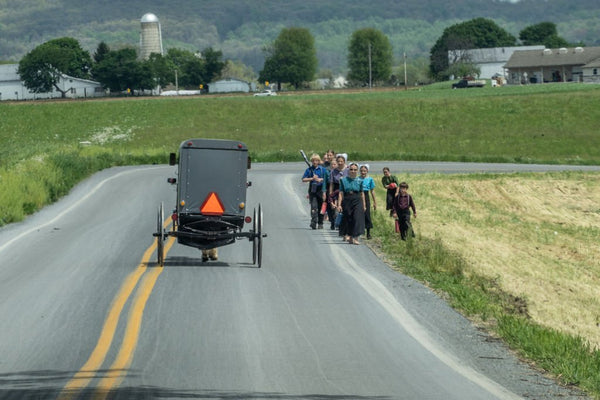
In general sociological thinking, cultural norms can be divided into two groups: laws and traits. Generally, these laws are set by the governing authority of the land, whereas the traits are the unwritten rules that are set by society.
Amish Norms Are Subject to Less Societal Influences
The Amish, however, live outside of the sphere of influence of many authorities. Seeing God as their only true authority, they have developed their norms according to His laws, and most traits that they have developed are a consequence of their faith.
Their distinct community laws and behavior have set them apart from most modern societal groups today. They have very limited interaction with outsiders and avoid the technologies that would bring them face-to-face with outside influences.
The Ordnung – a Guidebook of Amish Laws
Thus, their cultural norms remain almost indistinguishable from that of their 18th-century founders. This is further encouraged by their adherence to their own set of laws, called the Ordnung. These laws were agreed upon from the very beginning of Amish history.
Ordnung serves to protect and preserve Amish law and their pious way of life, and it’s mostly based on the interpretation of biblical texts. However, while most of the Ordnung has remained unchanged with time, it’s regularly reassessed and, if necessary, revised.
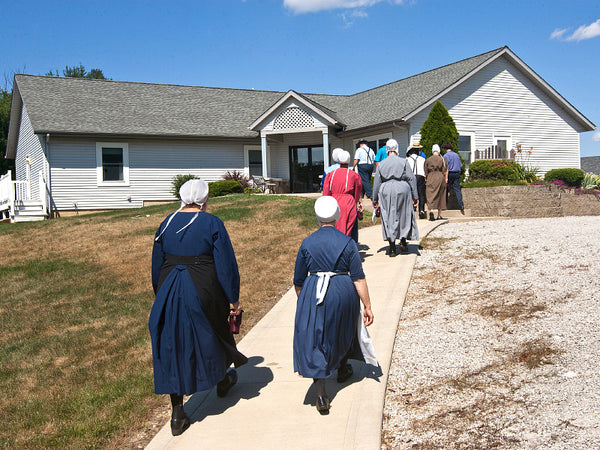
Amish Norms Exist to Preserve the Amish Community
This isn’t so much an update of Amish practices to keep in step with outside traditions as it’s a measure to ensure that the community’s best interests are still being served by the Ordnung. These revisions may also differ from one Amish community to the next.
Non-Amish communities are subject to trends and are in a constantly evolving state of flux. The more multicultural the world becomes, the more the lines between each group’s norms are blurred.
The same can’t be said of the Amish community. They resist conforming to modern living and instead practice time-honored Amish traditions.
Amish Traditions and Customs
When beliefs and customs are passed from one generation to the next, it’s said to be that cultural group’s tradition. Therefore, the Ordnung plays a large role in Amish laws and punishments. The Ordnung was based on interpretations of biblical texts and mandates and is never in opposition to their faith.
So, does this mean that Amish traditions are wholly faith-based? Not entirely, no. Many of their most distinctive traits are traceable, at least in part, to other influences. Even so, they can be said to support and nurture their faith-based traditions.
Let’s look at some of these:
The Amish Dress Code
The Amish have a very strict dress code, and this is observed in all Amish communities. While a slight difference may occur from one settlement to the next, the basic formula remains.
Women wear very plain, long dresses that completely cover their chests, upper arms, and legs.
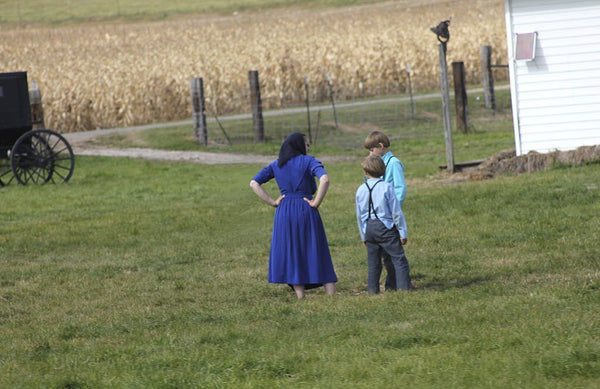
These dresses are worn with aprons, and sometimes a short cape for church. Amish women cover their heads with bonnets called kapps. No other forms of adornment, such as fashion accessories or jewelry, are tolerated. Men are also expected to wear simple shirts, trousers, suspenders, and hats.
While this can be traced to the Bible’s call for modesty in one’s appearance, it doesn’t wholly explain the style. Unfortunately, it’s often misconstrued as evidence that the Amish are a cult.
The Amish clothing worn today is almost exactly the same as that worn by European peasants of the 17th century. This is a direct influence from their Anabaptist founders in the Swiss/Alsace region of that time.
Beards with No Mustaches
All Amish Men, upon getting married, are expected to grow beards. They’re prohibited from shaving them, and this has become one of their most distinguishing traits. This, too, can be traced to biblical texts regarding men’s beards. But why don’t they have mustaches? Did the Bible prohibit them?
No, the reason for sporting full beards without mustaches, is due to something entirely different. The Amish are pacifists. Thus, they’ve never, (nor will they ever), been associated with the military. Violence in any form is strictly forbidden, and that means the military, as a vehicle for war, must be avoided.

Until 1916, British military soldiers were required to grow mustaches. In the British-occupied years preceding the American Revolution, they didn’t take kindly to conscientious objectors like the Amish. To distance themselves from this fashion that became synonymous with war, the Amish chose not to wear mustaches with their beards.
Carpentry Crafts
Carpentry is one of the first things outsiders think of when the topic of Amish traditions is raised. The Amish certainly have a talent for woodwork, especially building barns. This trade is passed down from father to son, and it also serves as a lucrative income stream for many Amish communities.
This is a trade that can be plied without the use of electrical tools. It certainly makes the task more difficult, but the Amish have honed these skills for generations. Most Amish don’t use modern tools, and they stick with traditional crafts that they can do with hard labor and the use of hand tools.
They also build schools, houses, and communal structures in their communities. These tend to be very simple and functional. The use of modern technology, and electricity from the public grid, are forbidden. This is their way of avoiding the temptations of outside life that can pose a threat to Amish culture.
Amish Baskets
Of course, it’s nearly impossible to discuss Amish traditions without touching on the subject of basket weaving. This, too, is a practice inherited from their European founders.
They hand-weave wicker baskets for their own use, like a woven harvest basket for gathering fresh produce from their farms. No Amish kitchen nook is without a vintage-style corner bread serving basket. Even the children enjoy the benefits of this ancient tradition, in the shape of beautifully crafted Easter egg baskets.
The art of basket weaving is seen as more than useful storage in the community. Many homewares, office supplies, and other practical items are made by the Amish for sale to those outside their community. By purchasing a woven dog bed basket or wicker bike basket, you can help to keep this tradition alive.
Amish Food
Even traditional Amish food is linked to their traditions. The Amish are primarily farming folk and, because they shy away from modern farming equipment, they put a lot of hard work into their farming, with very basic equipment.
Watching an Amish farmer at work, you’d be forgiven for thinking that you’ve been transported back in time. Tried and trusted traditional farming methods can work up a hefty appetite. Naturally, their meals have to be filling and nutritious.
Amish people tend to eat meals that are high in carbs, but that also strongly feature meat and fresh produce. They’re talented cheese producers too, just like their Swiss German forebears. Even the language the Amish speak can be traced back to these ancestors.
Strange ‘Nicknames’
One of the most amusing traditions of the Amish is their penchant for unusual and funny nicknames. These have an important purpose, though. The Amish aren’t allowed to marry outside of their faith and community, and they often name their children after relatives.
The Amish tend to have very large families, and this has led to an overabundance of particular names in each community. It’s not uncommon for there to be several boys named John, or several girls named Mary, in one community. To solve the problem of everyone in the community responding when a name is called, nicknames had to be introduced.
A common practice is to add the name of the parent onto the name, but when the child is named after their father, this only complicates the issue. This is how some very funny nicknames have resulted, for example, “Double John”.
Horse and Buggy Transport
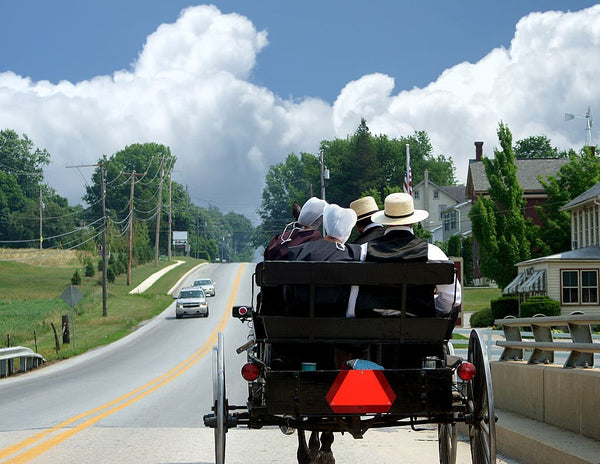
Have you ever seen a family of Amish, speaking German, riding in a horse-drawn cart? For most non-Amish, the only time they’ve seen an Amish family is when they ride their horse and buggy along a country lane. The Amish don’t own or operate motor vehicles. In fact, they’re prohibited from doing so.
There are different groups of Amish, and some are more progressive than others on this rule. When exceptions have been made to this rule, it’s almost always in more progressive New Order communities. The Old Order, the most conservative of Amish communities, doesn’t permit members of the community to own or drive cars.
This tradition has nothing to do with their faith. It’s linked to their staunch avoidance of relying on modern technology. The horse and buggy were the primary modes of transport of their founders. So, even to this day, Old Order Amish continue this tradition from the earliest Amish beginnings.
‘Bundling’
No group of people is without its own dating customs and youth culture. The Amish, too, have a unique set of courtship rituals. One of these is the practice of bundling.
This entails the two young people sharing a bed for the night, but this doesn’t mean what it would in most western societal groups. The Amish have a strict ban on premarital sexual activity. So, what’s the purpose of this tradition?
During bundling, the young couple is encouraged to stay awake until late and chat. It’s an opportunity to get to know each other. Yet it’s also a test of moral strength and self-control, as they’re both fully clothed, and have a wooden board between them.
‘Rumspringa’

One other Amish youth tradition that’s very misunderstood, is ‘Rumspringa’. Upon the age of 16, an Amish community member may be baptized into the faith. They may then marry and start a family soon after if they wish.
However, they also believe that this should be a matter of choice. Every member of the community must make their decision freely and never be subject to coercion. Thus, the concept of ‘Rumspringa’ was born. At this time, teenagers or young adults are allowed to experience the outside world, briefly.
This way, they can be aware of what they are giving up and can make an informed decision. Should they decide that despite these modern experiences, they’re happy to return to the Amish way of life, they may be baptized. Most Amish teenagers return to their communities.
Unusual Amish Traditions That Are More Faith and Values-Based
Some Amish norms are, of course, more directly influenced by their religious beliefs. So a quick delve into what these beliefs are is needed here.
The Amish believe, like many other Christian denominations, that God exists as a triune deity – Father, Son, and Holy Spirit. They believe that Jesus Christ, the Son, came to earth in human form and died to pay the penalty for humanity’s sins.
The Bible is seen as the ultimate guide to living a righteous life. As the word of God, it’s wise and infallible. God’s will plays a central role in Amish life. It affects the way they conduct themselves, how they view death, and even how they feel about modern practices like insurance. Let’s explain further:
Faceless Dolls and a Ban on Photos
The faces of Amish children’s dolls are blank, and this can be viewed by outsiders as odd or even eerie. There’s a sound traditional reason for it though.
Everyone is seen as equal in the eyes of God. Therefore, dolls aren’t given distinctive features. Other religious reasons have been postulated, such as the belief that dolls may become instruments of evil. Whatever the reason, this seems to be a tradition that’s very closely tied to the Amish religious beliefs.
The Bible is also the origin of the ban on photographs. Due to the Amish’s strict interpretation of the Bible’s admonition against graven images. They aren’t allowed to be photographed by themselves or others. This tends to be more prevalent in Old Order communities.
No Insurance
God’s Will is behind all occurrences, and nothing happens without it being a part of His plan. This is the central teaching of the Amish and it naturally affects how they live their lives. One such example is the refusal to take out insurance.
If a fire were to break out on an Amish community’s property, they would see it as part of God’s Plan. Although they may not understand His Will, they will accept the consequences and merely rebuild from the ashes.
At all times, the Amish place their trust in God over their abilities and ideas.
No Television or Pop Music
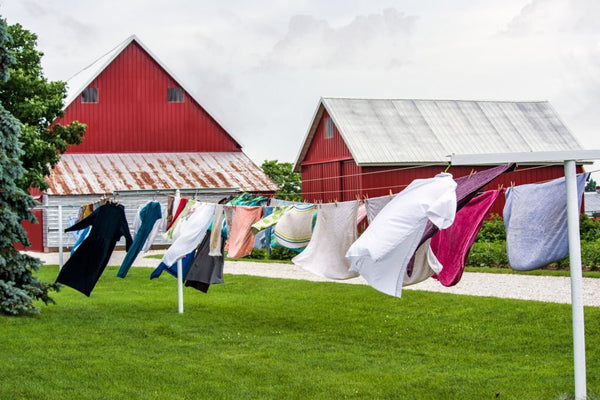
Vanity and pride are seen as sinful, and commonplace in modern western society. To avoid being influenced by these corrupt forces, television and radio are prohibited. These are seen as vessels for the promotion of immoral and sinful behavior.
In a similar vein, not only is listening to secular music frowned upon but so is the playing of musical instruments. Such forms of self-expression can be an open door to the feeding of the ego and the development of pride.
The ban on makeup and fashion accessories can also be tied to this belief. Pride and vanity aren’t condoned in the Bible, and they aren’t condoned by the Amish.
Amish Family Traditions
Some Amish traditions are more centered around the family. Family is very important to an Amish person, and two distinctive traits stand out in Amish families.
Large Families
Amish people tend to marry young, and also don’t use contraception, meaning there are a lot of large families. Having many children is viewed as a blessing from God. They see their lives as being a duty first to God, and then to family.
Community and family life are preserved by adhering to, amongst others, the traditions listed above. Gender roles in Amish society are very traditional, and this is most strongly evidenced in the family hierarchy.
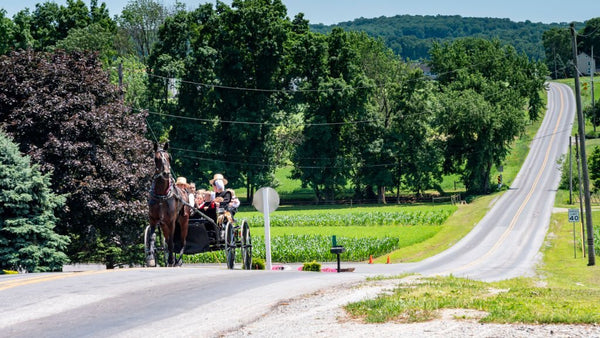
Patriarchal Hierarchy
Fathers are deemed to be the heads of their households. They’re the breadwinners and the source of teaching in every home. The women are mothers, housekeepers, and caregivers. While this may seem outrageous to modern-day feminists and gender studies students, the fact is: it works.
It’s this very same patriarchal family structure that’s ensured the continuation of their culture for centuries. It’s a throwback to the societal norms of their founders, and the role of the family set out in the Bible. Amish family traditions are not expected to change any time soon.
Conclusion
These are just a few of the many Amish traditions that are often misunderstood, and misrepresented, by the non-Amish community.
By learning the reasons behind some of these long-standing traditions, you will now have a deeper appreciation for them. It’s in our similarities, that we find common ground and initiate communication. However, it’s in our differences, that we all learn and grow.
Did You Find Our Blog Helpful? Then Consider Checking:



